By Leen Randell
Updated: Jul 04, 2024
10 Best Herbal Decoctions For Joint Pain
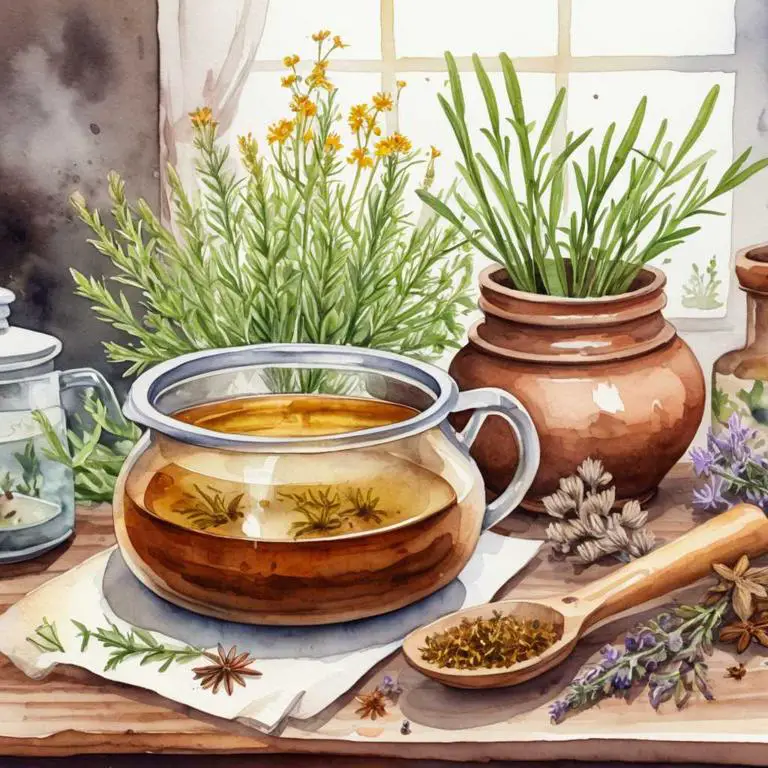
Herbal decoctions for joint pain are natural remedies made by steeping herbs in hot water to create a concentrated liquid extract.
These decoctions have been used for centuries to alleviate joint pain and inflammation, providing relief from conditions such as arthritis, gout, and fibromyalgia. Examples of herbs that can be used include turmeric, ginger, and devil's claw, which contain anti-inflammatory compounds that help reduce swelling and ease stiffness in joints.
By using these decoctions, individuals can experience improved mobility, reduced pain, and enhanced overall quality of life.
The following article describes in detail the most important decoctions for joint pain, including medicinal properties, parts of herbs to use, and recipes for preparations.
- 1. Glycyrrhiza glabra
- 2. Curcuma longa
- 3. Capsicum annuum
- 4. Ruscus aculeatus
- 5. Equisetum arvense
- 6. Urtica dioica
- 7. Sambucus nigra
- 8. Ginkgo biloba
- 9. Boswellia serrata
- 10. Cissus quadrangularis
- What is the best combination of herbal decoctions to use for joint pain?
- What ailments similar to joint pain are treated with herbal decoctions?
1. Glycyrrhiza glabra
Licorice decoctions helps with joint pain because it contains a compound called glycyrrhizin, which has anti-inflammatory properties that reduce swelling and alleviate discomfort.
The decoction also contains flavonoids and phenolic acids, which have antioxidant effects that help protect joints from further damage caused by free radicals.
Additionally, licorice root has been shown to inhibit the production of pro-inflammatory cytokines, leading to a decrease in joint pain and stiffness.

Medicinal Constituents
The list below shows the primary medicinal constituents in Glycyrrhiza glabra decoctions that help with joint pain.
- Glycyrrhizic acid: This triterpenoid saponin helps reduce joint pain by inhibiting the production of pro-inflammatory enzymes and cytokines, thereby reducing inflammation and oxidative stress.
- Licoricidin: This phenolic compound has anti-inflammatory and antioxidant properties, which help alleviate joint pain by reducing the production of pro-inflammatory mediators and scavenging free radicals.
- Isoliquiritigenin: This flavonoid compound exhibits potent anti-inflammatory and antioxidant activities, which contribute to the reduction of joint pain by inhibiting the production of pro-inflammatory enzymes and cytokines, and protecting against oxidative stress.
Parts Used
The list below shows the primary parts of licorice used to make decoctions for joint pain.
- Roots: Rich in glycyrrhizin, a compound with anti-inflammatory properties that helps alleviate joint pain.
- Barks: Contain flavonoids, phenolic acids, and saponins that contribute to their anti-inflammatory and analgesic effects.
- Leaves: Also contain glycyrrhizin and other bioactive compounds, but to a lesser extent than roots, still offering some therapeutic benefits.
Quick Recipe
The following recipe gives a procedure to make a basic licorice for joint pain.
- Gather 5-10 grams of dried glycyrrhiza glabra roots and clean them thoroughly in cold running water.
- Dry the cleaned roots in a low-temperature oven at 50-60 degrees celsius for 2 hours.
- Weigh the dried roots and add them to a pot of 500 milliliters of boiling distilled water.
- Boil the mixture for 10-15 minutes then reduce heat and simmer for 20-30 minutes.
- Strain the decoction through a cheesecloth or a fine-mesh sieve into a clean container.
2. Curcuma longa
Turmeric decoctions helps with joint pain because of its potent anti-inflammatory properties.
Curcumin, a compound found in turmeric, reduces inflammation by inhibiting enzymes that cause pain and swelling. As a result, it provides relief from joint stiffness, tenderness, and discomfort associated with conditions like arthritis. Additionally, curcumin's antioxidant properties help to neutralize free radicals that can damage joints over time.
Regular consumption of turmeric decoctions has been shown to improve joint mobility, reduce morning stiffness, and alleviate pain in individuals suffering from osteoarthritis.
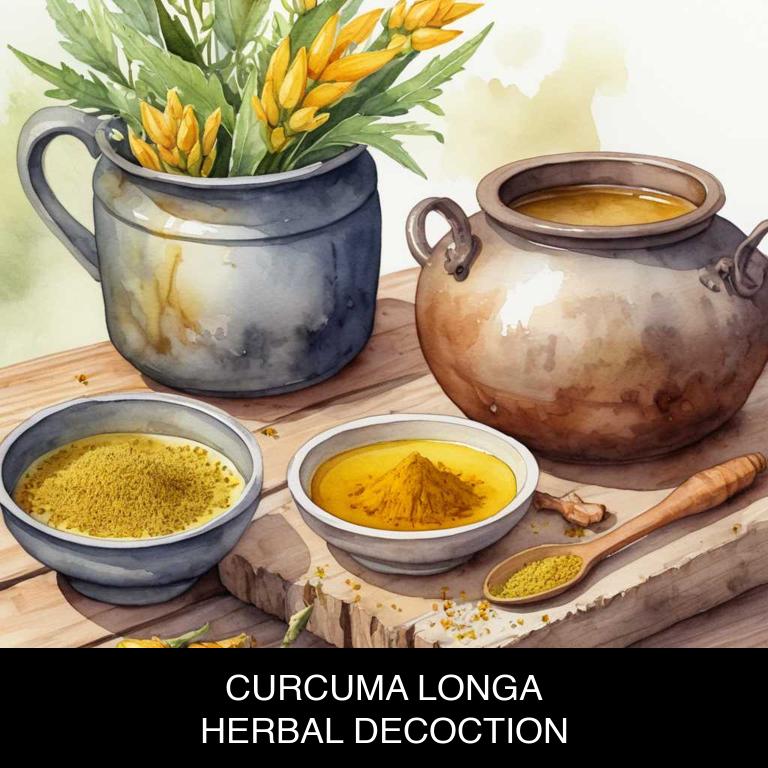
Medicinal Constituents
The list below shows the primary medicinal constituents in Curcuma longa decoctions that help with joint pain.
- Curcumin: Curcumin helps with joint pain by inhibiting the production of pro-inflammatory enzymes such as COX-2 and 5-LOX, which contribute to joint inflammation and pain.
- Demethoxycurcumin: DMC helps with joint pain by inhibiting the production of pro-inflammatory cytokines such as TNF-α, which play a key role in the progression of joint inflammation and pain.
- Beta-diketone: Beta-diketone helps with joint pain by inhibiting the production of pro-inflammatory enzymes and cytokines, and by reducing the production of inflammatory mediators such as prostaglandins and leukotrienes.
Parts Used
The list below shows the primary parts of turmeric used to make decoctions for joint pain.
- Rhyzomes: The rhyzomes are used due to their high content of curcumin, a bioactive compound with potent anti-inflammatory and pain-relieving properties.
- Roots: The roots of Curcuma longa are used to make decoctions for joint pain due to their high concentration of curcumin and other bioactive compounds.
- Seeds: The seeds of Curcuma longa are used in decoctions for joint pain as they contain a compound called demethoxycurcumin, which has anti-inflammatory and antioxidant properties.
Quick Recipe
The following recipe gives a procedure to make a basic turmeric for joint pain.
- Harvest 1-2 pieces of dried curcuma longa root 2-3 cm in length for maximum potency.
- Chop the harvested root into smaller pieces to increase surface area for infusion.
- Combine 1 teaspoon of chopped curcuma longa root with 2 cups of boiling water.
- Steep the mixture for 5-7 minutes or until the liquid turns yellowish in color.
- Strain the decoction through a fine mesh or cheesecloth to remove the solids completely.
3. Capsicum annuum
Bell pepper decoctions helps with joint pain because of its anti-inflammatory properties, which effectively reduce swelling and discomfort in the affected joints.
The decoction is rich in antioxidants that help to neutralize free radicals, further reducing inflammation and promoting healing. Additionally, bell peppers contain a compound called capsicum, which has been shown to inhibit the production of prostaglandins, hormone-like substances that contribute to pain and inflammation.
By incorporating bell pepper decoctions into their daily routine, individuals suffering from joint pain can experience significant relief and improved mobility.
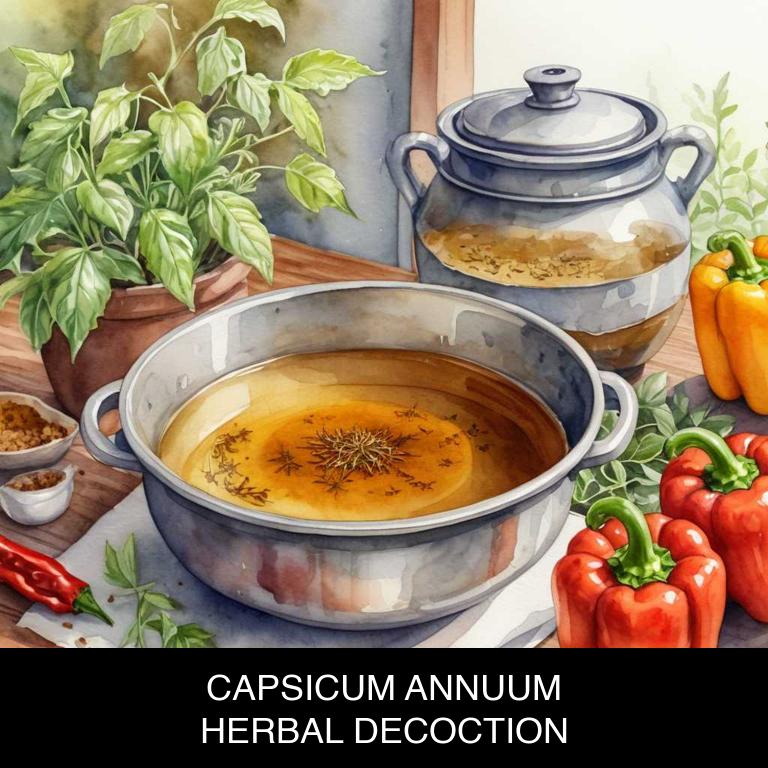
Medicinal Constituents
The list below shows the primary medicinal constituents in Capsicum annuum decoctions that help with joint pain.
- Capsaicin: Capsaicin helps with joint pain by blocking the production of a chemical called substance P, which transmits pain signals to the brain, thereby reducing inflammation and pain perception.
- Capsaicinoids: Capsaicinoids help with joint pain by inhibiting the release of pro-inflammatory neuropeptides, such as bradykinin and prostaglandins, which contribute to pain and inflammation in joints.
- Polysaccharides: Polysaccharides help with joint pain by stimulating the immune system to produce anti-inflammatory cytokines, such as IL-1 receptor antagonist and IL-10, which help to reduce inflammation and alleviate pain in joints.
Parts Used
The list below shows the primary parts of bell pepper used to make decoctions for joint pain.
- Fruits: They are the most commonly used part to make decoctions for joint pain due to their high concentration of capsaicin, which has anti-inflammatory properties.
- Leaves: They are used due to their ability to provide a milder alternative to fruits, still containing capsaicin and other compounds that help alleviate joint pain.
- Seeds: They are utilized for their rich content of capsaicin and other bioactive compounds, which contribute to their potential analgesic and anti-inflammatory effects for joint pain relief.
Quick Recipe
The following recipe gives a procedure to make a basic bell pepper for joint pain.
- Harvest fresh capsicum annuum fruits and wash them thoroughly with clean water under running tap.
- Chop 10-15 grams of the capsicum annuum fruits into small pieces and discard seeds.
- Combine chopped capsicum annuum with 500 milliliters of boiling water in a heat-resistant glass or ceramic container.
- Allow the mixture to steep for 15-20 minutes and then strain it using a cheesecloth or a fine-mesh sieve.
- Transfer the decoction to a clean glass bottle and store it in a cool dark place for up to 3 days.
4. Ruscus aculeatus
Dog holly decoctions helps with joint pain because they contain a unique combination of bioactive compounds that work synergistically to reduce inflammation and alleviate discomfort.
The anti-inflammatory properties of dog holly, particularly the presence of salicin and other polyphenols, help to ease stiffness and swelling in the joints, while its analgesic properties provide relief from pain.
This natural approach can be especially beneficial for dogs with degenerative joint disease or arthritis, as it helps to promote optimal joint health and mobility.
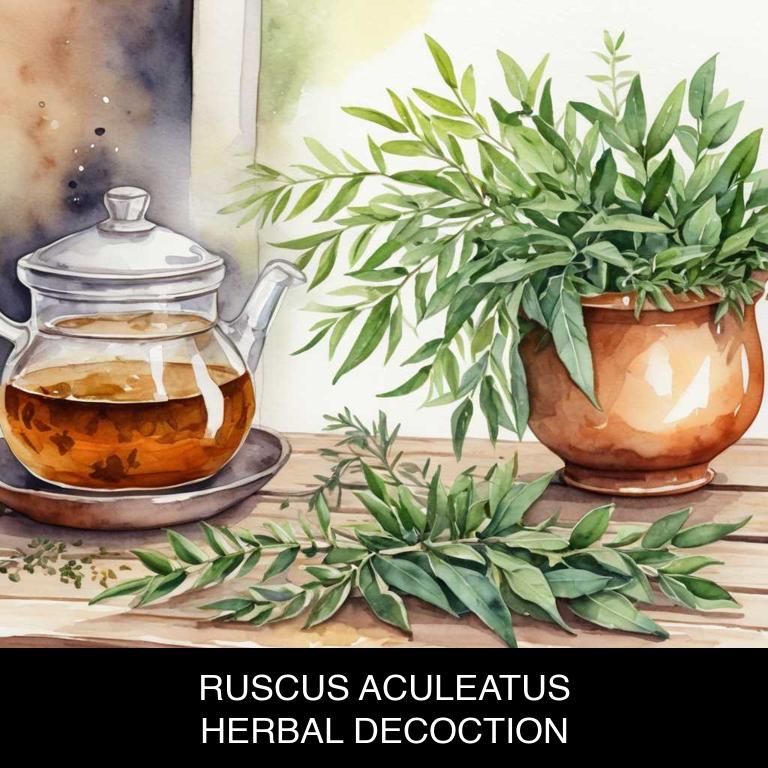
Medicinal Constituents
The list below shows the primary medicinal constituents in Ruscus aculeatus decoctions that help with joint pain.
- Ruscogenin: Ruscogenin has anti-inflammatory properties, which help in reducing joint pain and inflammation by inhibiting the production of pro-inflammatory enzymes.
- Saponins: Saponins in Ruscus aculeatus have anti-inflammatory and analgesic effects, which help in reducing pain and inflammation in joints.
- Sterols and triterpenes: Sterols and triterpenes present in Ruscus aculeatus have anti-inflammatory and antioxidant properties, which help in protecting the joints from oxidative stress and inflammation.
Parts Used
The list below shows the primary parts of dog holly used to make decoctions for joint pain.
- Roots: Used for their anti-inflammatory properties, which help to reduce joint pain and swelling.
- Leaves: Utilized for their analgesic and anti-inflammatory effects, which provide relief from joint pain and discomfort.
- Barks: Employed for their anti-inflammatory and analgesic properties, which help to alleviate joint pain and inflammation.
Quick Recipe
The following recipe gives a procedure to make a basic dog holly for joint pain.
- Gather 1-2 grams of dried ruscus aculeatus leaves and roots to use in decoction.
- Combine the dried plant material with 250 milliliters of water in a saucepan.
- Bring the water to a boil over high heat then reduce to a simmer for 10-15 minutes.
- Strain the decoction through a cheesecloth or a fine-mesh sieve into a bowl.
- Allow the decoction to cool and then refrigerate it for future use.
5. Equisetum arvense
Field horsetail decoctions helps with joint pain because they are rich in silica, a mineral that plays a crucial role in maintaining healthy connective tissue.
Silica helps to reduce inflammation and improve joint flexibility by strengthening the cartilage and tendons surrounding the joints.
Additionally, field horsetail decoctions contain antioxidants and anti-inflammatory compounds that help to alleviate joint pain and stiffness caused by conditions such as arthritis.
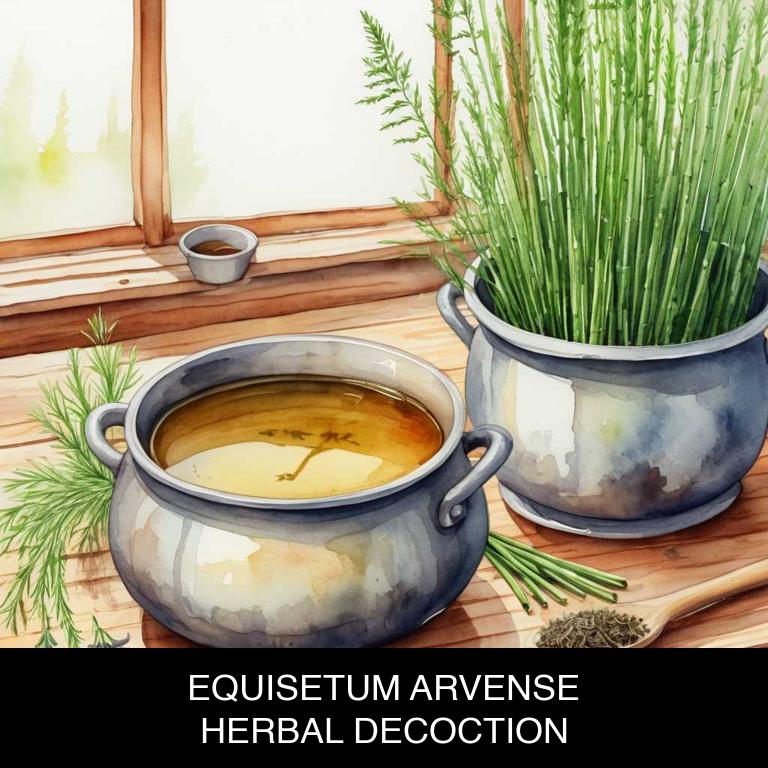
Medicinal Constituents
The list below shows the primary medicinal constituents in Equisetum arvense decoctions that help with joint pain.
- Saponins: These triterpenoid glycosides help with joint pain by reducing inflammation and inhibiting the production of pro-inflammatory cytokines, thereby alleviating pain and discomfort.
- Flavonoids: Flavonoids, such as flavone and isoflavone, present in Equisetum arvense have anti-inflammatory and antioxidant properties, which help to reduce joint inflammation and oxidative stress, leading to pain relief.
- Phenolic acids: Phenolic acids, including ferulic acid and caffeic acid, exhibit anti-inflammatory and analgesic properties, which help to alleviate joint pain by reducing inflammation and modulating pain signaling pathways.
Parts Used
The list below shows the primary parts of field horsetail used to make decoctions for joint pain.
- Roots: The roots of Equisetum arvense are commonly used due to their high concentration of silica and other compounds that help reduce inflammation and ease joint pain.
- Leaves: The leaves of Equisetum arvense are utilized for their antioxidant and anti-inflammatory properties, which aid in reducing joint pain and inflammation.
Quick Recipe
The following recipe gives a procedure to make a basic field horsetail for joint pain.
- Gather 20-30 grams of equisetum arvense rhizomes and roots and clean them thoroughly.
- Crush the equisetum arvense rhizomes and roots into a fine powder using a mortar.
- Combine 1-2 teaspoons of the equisetum arvense powder with 2 cups of boiling water in a saucepan.
- Simmer the mixture for 10-15 minutes over low heat then strain it using a cheesecloth.
- Store the decoction in a glass bottle in the refrigerator for up to 3 days.
6. Urtica dioica
Stinging nettle decoctions helps with joint pain because of its rich anti-inflammatory properties, which effectively reduce swelling and ease discomfort in affected joints.
The decoction's bioactive compounds, such as flavonoids and terpenoids, work to inhibit the production of prostaglandins, hormone-like substances that cause inflammation. Additionally, nettle's anti-arthritic properties help to soothe and calm joint tissues, reducing stiffness and promoting flexibility.
Regular consumption of nettle decoctions can lead to significant relief from joint pain and improved overall joint health.
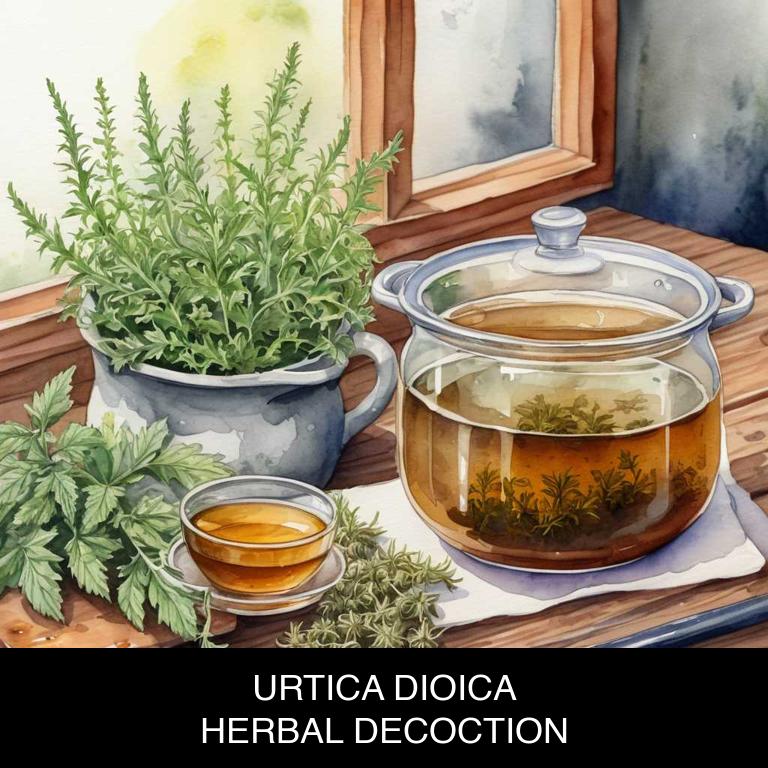
Medicinal Constituents
The list below shows the primary medicinal constituents in Urtica dioica decoctions that help with joint pain.
- Stigmasterol: A sterol found in Urtica dioica, stigmasterol has anti-inflammatory properties that help reduce joint pain and inflammation.
- Alkanes: Certain alkanes present in Urtica dioica decoctions have been found to have anti-inflammatory and immunomodulatory effects, which can contribute to alleviating joint pain.
- Iridoid glycosides: These compounds have potent anti-inflammatory and antioxidant properties, which can help reduce joint pain and inflammation caused by oxidative stress.
Parts Used
The list below shows the primary parts of stinging nettle used to make decoctions for joint pain.
- Leaves: They are the most widely used part due to their high content of salicylic acid, which acts as a natural pain reliever and anti-inflammatory.
- Roots: The roots are used for their anti-inflammatory properties, which help reduce swelling and pain in joints.
- Stems: The stems contain a compound called urticoside, which has analgesic and anti-inflammatory effects, making them effective in relieving joint pain.
Quick Recipe
The following recipe gives a procedure to make a basic stinging nettle for joint pain.
- Gather 25-50 grams of dried urtica dioica leaves and stems from a trusted supplier.
- Rinse the dried herbs with cold water to remove any impurities or debris.
- Combine the rinsed herbs with 500ml of cold water in a saucepan.
- Bring the mixture to a boil then reduce the heat to a simmer for 10-15 minutes.
- Strain the decoction through a cheesecloth or a fine-mesh sieve into a clean container.
7. Sambucus nigra
Elder decoctions helps with joint pain because of its potent anti-inflammatory properties.
The plant's bioactive compounds, such as flavonoids and phenolic acids, work synergistically to reduce inflammation and alleviate discomfort in the joints. Additionally, elder decoctions contain antioxidants that help protect cartilage from damage and promote healthy joint tissue.
By reducing swelling and improving mobility, elder decoctions offer a natural and effective solution for managing joint pain and promoting overall joint health.
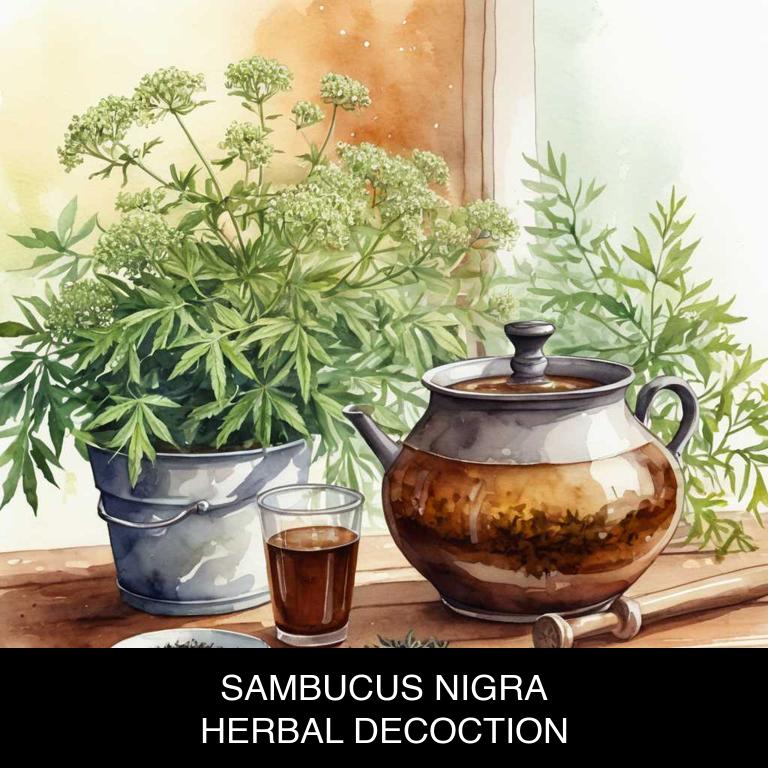
Medicinal Constituents
The list below shows the primary medicinal constituents in Sambucus nigra decoctions that help with joint pain.
- Flavonoids: Flavonoids, particularly quercetin, in Sambucus nigra decoctions help with joint pain by reducing inflammation and oxidative stress in the body, which contributes to joint damage and pain.
- Phenolic acids: Phenolic acids, such as ferulic acid, in Sambucus nigra decoctions help with joint pain by inhibiting the production of pro-inflammatory mediators, such as prostaglandins and leukotrienes, which exacerbate joint inflammation and pain.
- Anthocyanins: Anthocyanins, powerful antioxidants found in Sambucus nigra decoctions, help with joint pain by reducing oxidative stress and inflammation in the body, which contributes to joint damage and pain.
Parts Used
The list below shows the primary parts of elder used to make decoctions for joint pain.
- Flowers: The flowers of Sambucus nigra are rich in flavonoids and anthocyanins, which have anti-inflammatory properties that help reduce joint pain and inflammation.
- Leaves: The leaves of Sambucus nigra contain salicylic acid, a compound that has anti-inflammatory and analgesic properties, making it effective in relieving joint pain and inflammation.
- Fruits: The fruits of Sambucus nigra, also known as elderberries, contain anthocyanins and flavonoids that have anti-inflammatory and antioxidant properties, which help to reduce joint pain and inflammation.
Quick Recipe
The following recipe gives a procedure to make a basic elder for joint pain.
- Gather 30-60 grams of dried sambucus nigra flowers and 50-100 ml of water for decoction.
- Combine the dried sambucus nigra flowers with water in a saucepan and bring to a boil.
- Reduce heat to low and simmer the mixture for 10-15 minutes or until liquid is reduced by half.
- Strain the decoction using a cheesecloth or fine-mesh sieve into a clean container.
- Allow the decoction to cool and refrigerate for up to 24 hours before consumption.
8. Ginkgo biloba
Maidenhair tree decoctions helps with joint pain because they are rich in antioxidants and anti-inflammatory compounds, which work together to reduce inflammation and alleviate discomfort.
The decoctions' ability to target inflamed joints and tissues allows for effective relief from stiffness, soreness, and swelling. Additionally, the decoction's antioxidant properties help protect joint cartilage and connective tissue from damage caused by free radicals, promoting overall joint health and mobility.
As a result, maidenhair tree decoctions can provide natural relief from joint pain and improve overall quality of life.
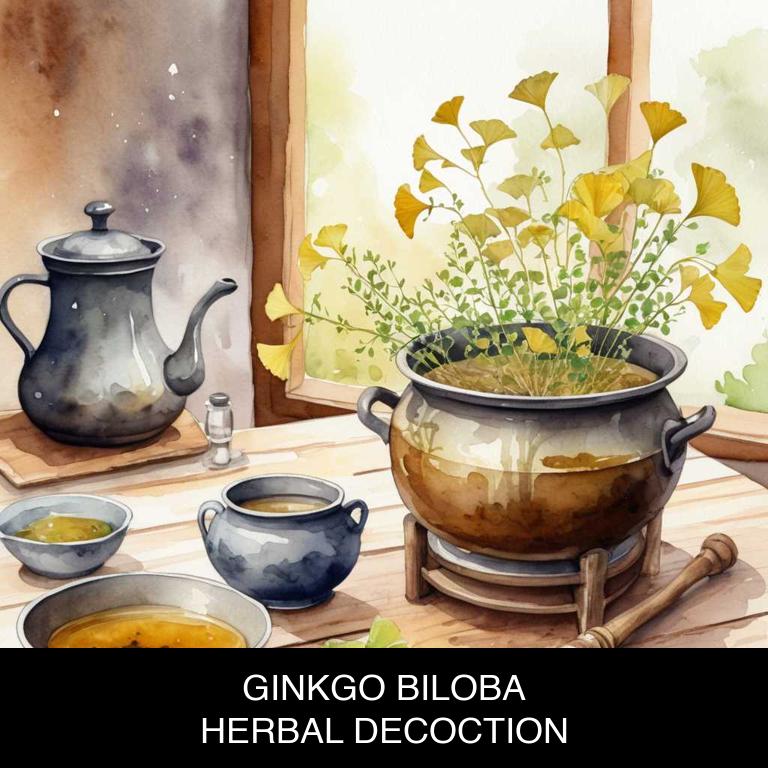
Medicinal Constituents
The list below shows the primary medicinal constituents in Ginkgo biloba decoctions that help with joint pain.
- Ginkgolides: These diterpenoid lactones have anti-inflammatory properties, which help reduce joint inflammation and alleviate pain associated with conditions like osteoarthritis.
- Bilobalide: This sesquiterpenoid trilactone has antioxidant and anti-inflammatory effects, which help protect joints from oxidative stress and inflammation, thus reducing joint pain and discomfort.
- Flavonoids: Specifically, quercetin and kaempferol, are known for their anti-inflammatory and antioxidant properties, which help reduce joint inflammation, pain, and swelling, and may also improve joint function and mobility.
Parts Used
The list below shows the primary parts of maidenhair tree used to make decoctions for joint pain.
- Leaves: They are rich in flavonoids and terpenoids, which are believed to contribute to their anti-inflammatory and antioxidant properties.
- Roots: The roots contain triterpenoid saponins, which have been shown to have anti-inflammatory and analgesic effects, helping to alleviate joint pain.
- Buds: The buds of Ginkgo biloba contain flavonoids and terpenoids that have been traditionally used to treat joint pain and inflammation due to their antioxidant and anti-inflammatory properties.
Quick Recipe
The following recipe gives a procedure to make a basic maidenhair tree for joint pain.
- Select high-quality dried ginkgo biloba leaves with a minimum of 24% flavone glycosides content.
- Measure 2-4 grams of dried ginkgo biloba leaves for a standard decoction serving.
- Combine the measured ginkgo biloba leaves with 250-500 milliliters of water in a saucepan.
- Bring the ginkgo biloba and water mixture to a boil then reduce heat to a simmer for 15-30 minutes.
- Strain the decoction through a cheesecloth or fine-mesh sieve into a separate container for consumption.
9. Boswellia serrata
Frankincense decoctions helps with joint pain because of its potent anti-inflammatory properties, which reduce swelling and ease stiffness in the joints.
The decoction's ability to penetrate deep into the tissues also allows for effective relief from chronic inflammation, a common underlying cause of joint pain. Additionally, frankincense has been shown to stimulate the production of natural lubricants in the joints, reducing friction and discomfort.
By addressing both acute and chronic inflammation, frankincense decoctions provide comprehensive relief from joint pain.
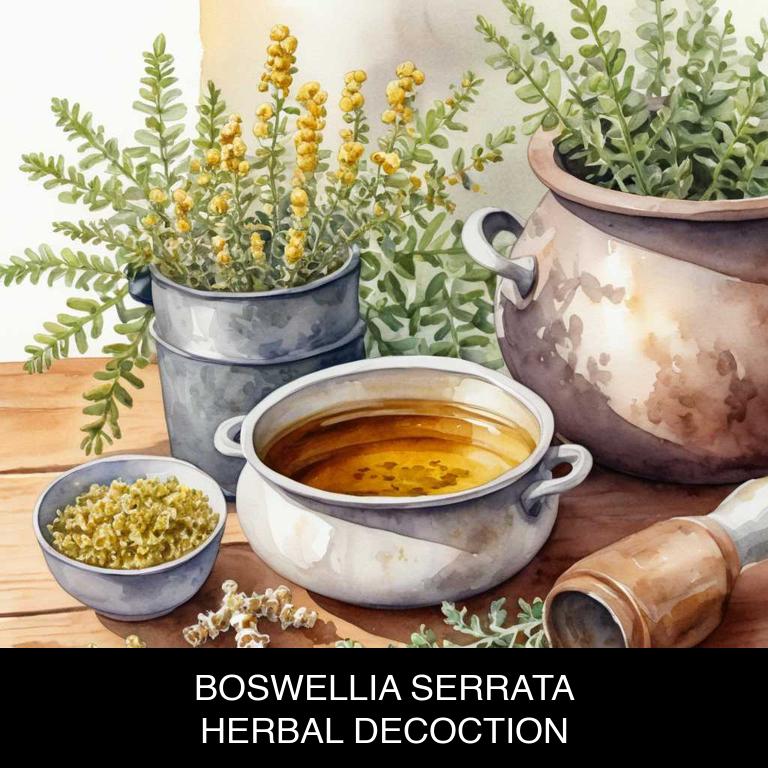
Medicinal Constituents
The list below shows the primary medicinal constituents in Boswellia serrata decoctions that help with joint pain.
- Boswellic acids: These triterpenoids help reduce joint inflammation by inhibiting the production of pro-inflammatory enzymes and mediators, thereby alleviating pain and discomfort.
- Acetyl-11-keto-β-boswellic acid: AKBA is a boswellic acid derivative that has potent anti-inflammatory and analgesic properties, helping to reduce joint pain and inflammation by blocking the action of pro-inflammatory cytokines and enzymes.
- Β-boswellic acid: β-BA is another boswellic acid that helps reduce joint pain by inhibiting the production of pro-inflammatory mediators and enzymes, thereby reducing inflammation and pain in the joints.
Parts Used
The list below shows the primary parts of frankincense used to make decoctions for joint pain.
- Roots: The roots of Boswellia serrata are primarily used to make decoctions for joint pain due to their high concentration of boswellic acids.
- Rhyzomes: Boswellia serrata rhyzomes are used due to their ability to retain the active compounds, such as boswellic acids, which help in reducing joint inflammation.
- Barks: The bark of Boswellia serrata is used in decoctions for joint pain as it contains boswellic acids, which help in reducing pain and inflammation.
Quick Recipe
The following recipe gives a procedure to make a basic frankincense for joint pain.
- Gather 500-750 milligrams of dried boswellia serrata resin powder.
- Combine the powder with 1 quart of boiling water in a saucepan.
- Boil the mixture for 10-15 minutes or until the liquid is reduced to half.
- Strain the decoction through a cheesecloth or a fine-mesh sieve into a clean container.
- Allow the decoction to cool and store it in the refrigerator for up to 3 days.
10. Cissus quadrangularis
Veldt grape decoctions helps with joint pain because of its unique combination of flavonoids, phenolic acids, and anthocyanins.
These bioactive compounds work together to reduce inflammation, alleviate oxidative stress, and enhance the body's natural healing processes. The decoction's potent antioxidant properties help neutralize free radicals that contribute to joint degradation, while its anti-inflammatory effects minimize swelling and pain in affected joints.
As a result, veldt grape decoctions can provide relief from arthritis symptoms and promote overall joint health and comfort.
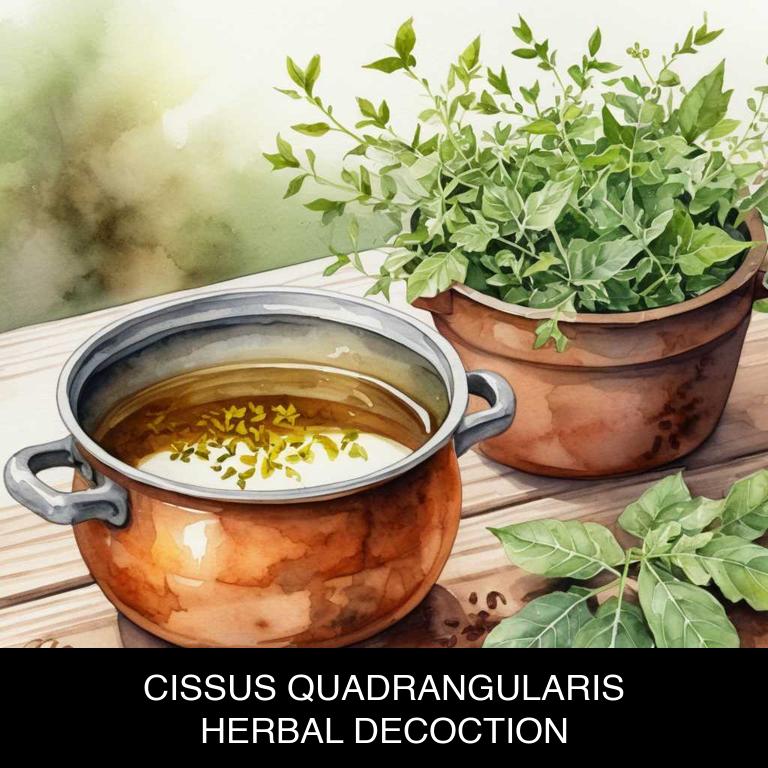
Medicinal Constituents
The list below shows the primary medicinal constituents in Cissus quadrangularis decoctions that help with joint pain.
- Oleanolic acid: This triterpenoid saponin has anti-inflammatory properties, which help reduce swelling and alleviate joint pain in individuals with osteoarthritis.
- Quercetin: This flavonoid polyphenol has potent anti-inflammatory and antioxidant effects, which contribute to the reduction of joint inflammation and pain associated with conditions like osteoarthritis.
- Cissus quadrangularis glycosides: These glycosides, particularly the flavonoid glycosides, have been shown to have anti-inflammatory and chondroprotective effects, which help protect cartilage and alleviate joint pain in individuals with osteoarthritis.
Parts Used
The list below shows the primary parts of veldt grape used to make decoctions for joint pain.
- Stems: Stems of Cissus quadrangularis are often used due to their high concentration of anti-inflammatory compounds that can help alleviate joint pain.
- Roots: Roots are another commonly used part of the plant, as they contain bioactive compounds that may help reduce inflammation and promote healing in joints.
- Leaves: Leaves of Cissus quadrangularis are also utilized in decoctions, possibly due to their content of flavonoids and other antioxidants that can help mitigate joint pain and inflammation.
Quick Recipe
The following recipe gives a procedure to make a basic veldt grape for joint pain.
- Harvest fresh cissus quadrangularis vines in the morning after the dew has evaporated for optimal quality.
- Clean the vines thoroughly with water to remove dirt and impurities from the surface.
- Chop 500 grams of the clean cissus quadrangularis vines into small pieces to release their active compounds.
- Combine the chopped vines with 2 liters of boiling water and allow the mixture to steep for 30 minutes.
- Strain the decoction through a cheesecloth or fine-mesh sieve into a clean container to separate solids from liquid.
What is the best combination of herbal decoctions to use for joint pain?
The best combination of herbal decoctions that help with joint pain is a blend of turmeric, ginger, and willow bark.
Turmeric contains curcumin, a natural anti-inflammatory that reduces joint swelling and pain. Ginger has anti-inflammatory properties that ease joint stiffness and promote circulation. Willow bark contains salicin, a compound similar to aspirin that reduces pain and inflammation.
This combination can be made into a tea by steeping equal parts of dried turmeric, ginger, and willow bark in hot water.
What ailments similar to joint pain are treated with herbal decoctions?
Ailments similar to joint pain that are treated with herbal decoctions are arthritis, rheumatism, and gout.
Turmeric-based decoctions are commonly used to reduce inflammation and alleviate symptoms of these conditions. Ginger, ashwagandha, and willow bark are also popular herbs used in decoctions to provide relief from pain and stiffness.
These natural remedies can help to reduce swelling, improve mobility, and promote overall joint health.